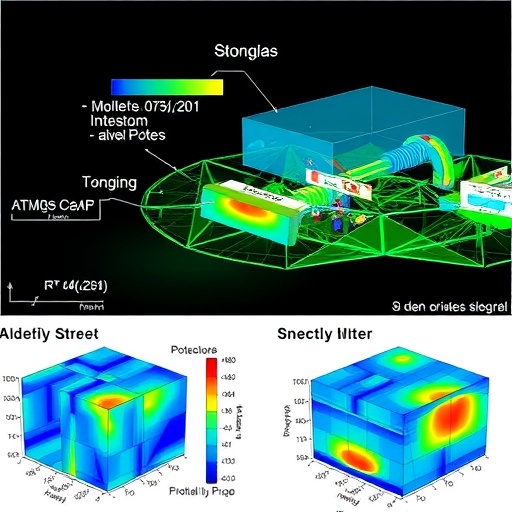In an era where urban air quality is a burgeoning concern, the innovative research conducted by Sattari et al. in their recent study highlights the potential of advanced monitoring techniques. Centering on the city of Warsaw, the study investigates how integrating a dense network of sensors can amplify the accuracy of the ATMO-Street model, a sophisticated framework designed for air quality assessment. The research addresses the formidable challenge of pollution monitoring in densely populated urban areas, where conventional methods often fall short.
The emphasis of this study lies in understanding the sources of emissions that contribute to air quality degradation. The ATMO-Street model, which has been widely recognized for its somewhat accurate predictions of air pollutants, required enhancement to ensure it could effectively manage the complexities of emissions in an urban landscape like Warsaw. Through this research, Sattari and his team meticulously analyzed various emission sources, a task made feasible through the deployment of a high-density sensor network across the city.
The sensor network deployed as part of the research was not typically seen in conventional studies. By utilizing an extensive array of sensors distributed throughout key locations in Warsaw, researchers could gather real-time data that reflects the nuances of air quality variations across different neighborhoods. This pioneering approach facilitated a more granular understanding of how various emissions engendered by traffic, industrial activities, and other urban sources contribute to the city’s air quality.
One of the remarkable aspects of the study is the collaboration between various stakeholders, including local government bodies, environmental agencies, and research institutions. This collaborative framework ensured that the sensor network was positioned optimally to capture critical data across diverse urban environments. By working together, the team has set a precedent for future research models that could apply similar methodologies in urban settings worldwide.
Data collected from the dense sensor network has allowed researchers to develop robust algorithms that enhance the predictability of the ATMO-Street model. This development is crucial because traditional air quality models often rely on sparse data, which can reduce their accuracy significantly. With the rich dataset acquired from this sensor network, the researchers were able to calibrate the model to account for dynamic factors such as weather patterns and traffic fluctuations.
The findings from this extensive research indicate that the enhanced ATMO-Street model offers a more reliable prediction of pollutant levels. The calibration process involved not only statistical adjustments but also the integration of machine learning techniques to refine the outputs further. This combination of traditional modeling with cutting-edge technology underscores the potential for innovation in environmental science.
Moreover, the extensive data gathered has implications beyond the city limits of Warsaw. This research opens avenues for transnational efforts to address urban air pollution by showcasing how localized studies can inform broader environmental policies. Other cities grappling with similar air quality challenges could replicate the methodologies employed in this study, thereby ranking urban health as a priority across nations.
One noteworthy aspect of the sensor network implemented in Warsaw is its ability to provide real-time monitoring, a crucial feature often overlooked in traditional models. With continuous updates, city planners and policymakers can respond to emergencies and pollution spikes more effectively. The timeliness of data dissemination allows for proactive measures, potentially leading to immediate decisions that can enhance public health outcomes.
The implications of this research extend into community engagement as well. By making air quality data available to the public, residents can become more informed and active participants in advocating for cleaner air. Transparency in environmental monitoring can foster a sense of empowerment among citizens, enabling them to demand accountability from local industries and governmental authorities.
In the face of rising global environmental issues, studies like that conducted by Sattari et al. illustrate the necessity of integrating technology into environmental policy. The insights gained from the ATMO-Street model and the dense sensor network can contribute significantly to understanding and mitigating air pollution in urban areas. Policymakers are urged to take heed of the implications that arise from accurate data and use them to inform legislation that ultimately supports cleaner, safer environments for their constituents.
This research also raises discussions on funding and resource allocation for urban monitoring initiatives. The study underscores how, with the right investments, cities can deploy cutting-edge technology to tackle air quality issues more aggressively. A commitment to environmental monitoring must be matched with proper financial backing and logistical support, ensuring that advances in research translate into tangible benefits for urban populations.
Furthermore, as the world becomes increasingly urbanized, the demand for innovative solutions to mitigate pollution and enhance public health is paramount. The methodologies exemplified in this research can serve as a blueprint, not just for European cities like Warsaw but for urban areas around the globe facing similar environmental challenges.
In conclusion, Sattari et al.’s study is a clarion call for cities to embrace advanced technologies as a means to fight air pollution effectively. Their research not only reinforces the credibility of the ATMO-Street model but also paves the way for future studies focused on emission control and urban health improvement. The collaborative efforts exhibited in this case study spotlight a critical path forward in the relentless quest for cleaner air in our bustling cities.
Subject of Research: Air Quality Improvement via Advanced Monitoring in Urban Areas
Article Title: Enhancing ATMO-Street model accuracy through emission source analysis using a dense sensor network: a Warsaw case study.
Article References:
Sattari, A., Hooyberghs, H., Janssen, S. et al. Enhancing ATMO-Street model accuracy through emission source analysis using a dense sensor network: a Warsaw case study. Environ Monit Assess 197, 1123 (2025). https://doi.org/10.1007/s10661-025-14603-4
Image Credits: AI Generated
DOI:
Keywords: Urban air quality, sensor network, ATMO-Street model, emission source analysis, environmental monitoring.




